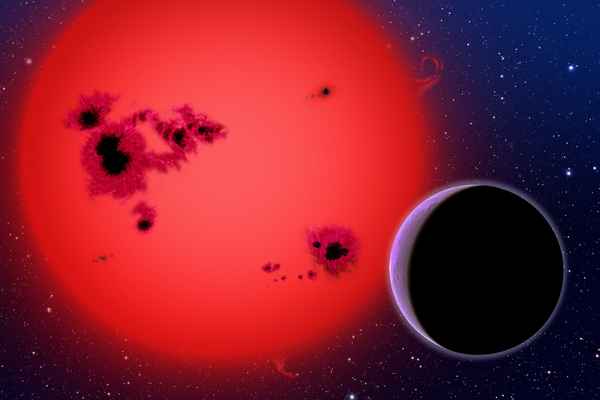
by Brian Fisher Johnson Thursday, January 5, 2012

Newly discovered super-Earth GJ 1214b orbits a red dwarf star 40 light-years from Earth in this artist's conception. David A. Aguilar, CfA
The search for Earth-like planets has never looked better. Scientists say they have discovered a water-rich planet that is only 2.7 times larger than Earth. Although positioned just outside the habitable zone for life, the planet gives scientists their best hope yet that other Earth-like planets exist in our universe.
More than 300 planets are known to orbit stars other than our own sun. Recently, however, astronomers have taken a particular interest in finding super-Earths, planets with masses between about 1.5 and 15 times that of our planet. Although large compared to Earth, super-Earths are smaller than gas giants such as Jupiter or Saturn. This includes CoRoT-7b, an extremely hot, rocky planet discovered in February 2009. The newly discovered planet, dubbed GJ 1214b, is also a super-Earth.
Like CoRoT-7b, GJ 1214b is detectable from Earth when it passes in front of its star during its orbit, said David Charbonneau, an astronomer at Harvard University in Cambridge, Mass., during a press conference on Monday to announce the find. Charbonneau and his colleagues calculated that GJ 1214b completes its orbit every 1.6 days and has a radius about 2.7 times that of Earth’s. They will publish their findings tomorrow in Nature.
Moreover, Charbonneau and his colleagues found, GJ 1214b has 6.6 times more mass than Earth but is only a fraction as dense. That suggests GJ 1214b is a wet world compared to rocky Earth, with a core and mantle surrounded by a deep ocean that makes up about half of GJ 1214b’s mass, wrote Geoffrey Marcy, an astronomer at the University of California at Berkeley, in an accompanying paper in Nature.
GJ 1214b’s orbit is close to its star, and is therefore too hot to put it within the “habitable zone,” Charbonneau said at the press conference. The habitable zone is the distance from a star’s radiation at which a planet’s water can remain liquid as it does on Earth. Despite the heat, GJ 1214b’s water is likely kept liquid by the pressure of its thick atmosphere. That atmosphere would also block out light from GJ 1214b’s star, meaning the planet’s ocean surface is likely a dark place.
Still, “there’s every reason to think that we're going to find some more planets that are a little bit farther out from their star, and just a little bit cooler, and therefore truly Earth-like,” Charbonneau said.
The discovery highlights the advantages of focusing on certain types of stars in the search for Earth-like planets, Charbonneau said. It would make sense, for example, to look for Earth-like planets around stars similar to our own sun.
Charbonneau is a participating scientist with NASA’s Kepler Mission, which is searching for just such stars. He and his team, however, are focusing their search on M dwarfs, a much smaller, dimmer, and more common type of star than our sun. Because these stars are dimmer, GJ 1214b and other planets that orbit M dwarfs block a relatively large amount of their stars’ luminescence as they pass between Earth and their star. Additionally, planets like GJ 1214b that are near the habitable zone orbit around M dwarfs quickly — they must be closer to M dwarfs to receive the right amount of radiation. That means astronomers would not need to focus on an M dwarf very long to study its orbiting planet, Charbonneau said.
Indeed, searching for planets around M dwarfs could be the best bet for finding life in the near future, says David Bennett, an astronomer at the University of Notre Dame in South Bend, Ind. “While the chances of finding life on a planet orbiting a more massive star like ours might be higher, these objects are much easier to search. So maybe we might do better by searching 10 such stars for life than searching for one ‘Earth’ orbiting a solar-type star,” Bennett says.
GJ 1214b’s unique position will also help astronomers study the planet’s atmosphere, Charbonneau added at the press conference. GJ 1214b is only 40 light-years away from Earth and orbits a small star. Other super-Earths, such as CoRoT-7b, which is about 500 light-years from Earth, are too far away for astronomers to analyze their atmospheres. Likewise, the chemical signatures of the atmospheres on planets that orbit large stars (like CoRoT-7b’s star) would also be obscured by the star’s radiance.
That ability to analyze a planet’s atmosphere will be key in our search for life, Charbonneau said. Assuming astronomers did find an Earth-like planet in the habitable zone, they would next test its atmosphere for biomarkers such as oxygen, a product of photosynthetic life. Given that GJ 1214b just missed the habitable zone, Charbonneau said, “I think there’s every indication that we’re going to get into this business of finding habitable worlds and studying their atmospheres in the next five years.”
© 2008-2021. All rights reserved. Any copying, redistribution or retransmission of any of the contents of this service without the expressed written permission of the American Geosciences Institute is expressly prohibited. Click here for all copyright requests.